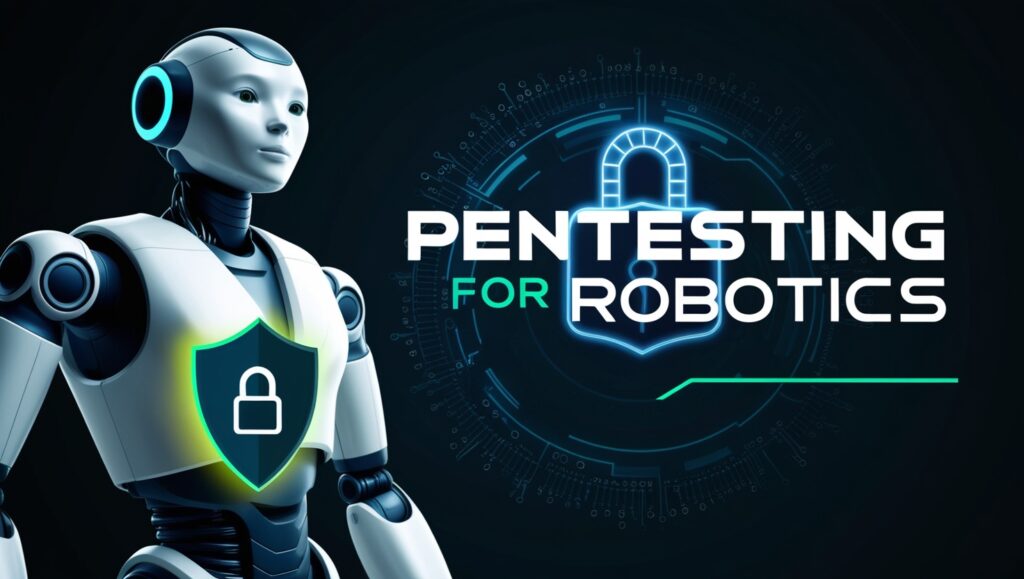robotics is no longer confined to science fiction. From industrial automation to healthcare and even household chores, robots are becoming an integral part of our lives. However, with this rise in robotic systems comes a growing need for robust cybersecurity measures. This is where Pentesting for Robotics comes into play. In this blog, we’ll explore the importance of penetration testing in robotics, common vulnerabilities, tools, techniques, and best practices to secure these advanced systems.

1. Introduction to Pentesting for Robotics
Pentesting for Robotics refers to the process of simulating cyberattacks on robotic systems to identify vulnerabilities and weaknesses. Just like traditional IT systems, robots are susceptible to hacking, data breaches, and unauthorized access. Penetration testing helps organizations proactively identify and fix these issues before malicious actors can exploit them.
Robotic systems often operate in critical environments, such as manufacturing plants, hospitals, and even military applications. A security breach in these systems can lead to catastrophic consequences, including financial losses, operational downtime, and even physical harm. By conducting Pentesting for Robotics, organizations can ensure their systems are secure, reliable, and resilient against cyber threats.
2. The Growing Intersection of Cybersecurity and Robotics
As robotics technology advances, so does its integration with IoT, AI, and cloud computing. While these advancements enhance functionality, they also introduce new security challenges. For instance, connected robots often rely on wireless communication, which can be intercepted or manipulated by attackers.
The intersection of cybersecurity and robotics is becoming increasingly critical. A single vulnerability in a robotic system can compromise an entire network, leading to data theft, operational disruptions, or even physical damage. Pentesting for Robotics plays a vital role in addressing these challenges by identifying potential attack vectors and ensuring robust security measures are in place.
3. Common Vulnerabilities in Robotic Systems
Robotic systems are complex, and their vulnerabilities can stem from hardware, software, or even human error. Here are some common vulnerabilities that Pentesting for Robotics aims to address:
- Insecure Communication Channels: Many robots rely on wireless communication, which can be intercepted or jammed by attackers.
- Weak Authentication Mechanisms: Default or weak passwords can provide easy access to robotic systems.
- Firmware Vulnerabilities: Outdated or unpatched firmware can expose robots to known exploits.
- Physical Security Risks: Robots operating in public spaces may be physically tampered with or stolen.
By identifying these vulnerabilities, penetration testing helps organizations implement targeted security measures to protect their robotic systems.
4. The Pentesting Process for Robotics
The Pentesting for Robotics process involves several key steps:
- Reconnaissance and Information Gathering: Collecting data about the robotic system, including its architecture, communication protocols, and software versions.
- Threat Modeling: Identifying potential threats and attack vectors based on the gathered information.
- Exploitation and Vulnerability Assessment: Simulating attacks to identify weaknesses and assess their impact.
- Post-Exploitation Analysis: Analyzing the results to determine the root cause of vulnerabilities and recommending remediation measures.
This structured approach ensures that all aspects of the robotic system are thoroughly tested for security flaws.
5. Tools and Techniques for Robotic Pentesting
To conduct effective Pentesting for Robotics, security professionals rely on a variety of tools and techniques. Some commonly used tools include:
- Network Scanning Tools: Tools like Nmap and Wireshark help identify open ports and analyze network traffic.
- Firmware Analysis Tools: Tools such as Binwalk and Ghidra are used to analyze and reverse-engineer firmware.
- Simulation Environments: Platforms like Gazebo and ROS (Robot Operating System) allow testers to simulate robotic systems in a controlled environment.
These tools, combined with manual testing techniques, provide a comprehensive assessment of the robotic system’s security posture.
6. Case Studies: Real-World Examples of Robotic System Breaches
Real-world examples highlight the importance of Pentesting for Robotics. Here are a few notable cases:
- Industrial Robots: In 2017, researchers demonstrated how industrial robots could be hacked to perform dangerous actions, such as moving unpredictably or leaking sensitive data.
- Service Robots: A popular home robot was found to have a vulnerability that allowed attackers to eavesdrop on conversations and steal personal data.
- Autonomous Vehicles: Hackers have successfully exploited vulnerabilities in self-driving cars, gaining control over steering and braking systems.
These cases underscore the need for proactive security measures, including regular penetration testing.
7. Best Practices for Securing Robotic Systems
To ensure the security of robotic systems, organizations should follow these best practices:
- Implement a Secure Development Lifecycle: Integrate security into every stage of the robotic system’s development.
- Conduct Regular Security Audits: Perform periodic penetration testing to identify and address vulnerabilities.
- Use Strong Authentication Mechanisms: Enforce the use of complex passwords and multi-factor authentication.
- Keep Firmware and Software Updated: Regularly update robotic systems to patch known vulnerabilities.
By adopting these practices, organizations can significantly reduce the risk of cyberattacks on their robotic systems.
8. Ethical Considerations in Robotic Pentesting
While Pentesting for Robotics is essential for security, it also raises ethical questions. Testers must ensure that their activities do not cause harm or disrupt operations. Additionally, they should adhere to legal guidelines and obtain proper authorization before conducting tests.
Ethical hacking also involves responsible disclosure. If a vulnerability is discovered, it should be reported to the relevant stakeholders promptly to prevent exploitation by malicious actors.
9. Future Trends in Robotic Security
The field of Pentesting for Robotics is constantly evolving. Here are some future trends to watch:
- AI and Machine Learning: These technologies will play a key role in detecting and mitigating cyber threats in real-time.
- Blockchain: Blockchain technology can enhance the security of robotic systems by providing tamper-proof data storage and communication.
- Emerging Threats: As robotics technology advances, new attack vectors will emerge, requiring innovative security solutions.
Staying ahead of these trends will be crucial for ensuring the long-term security of robotic systems.
10. Conclusion: The Importance of Proactive Security in Robotics
In conclusion, Pentesting for Robotics is a critical component of securing the future of automation. By identifying vulnerabilities and implementing robust security measures, organizations can protect their robotic systems from cyber threats. As robotics technology continues to advance, proactive security practices will be essential for ensuring the safety, reliability, and resilience of these systems.
11. FAQ Questions
Q1: What is Pentesting for Robotics?
A: Pentesting for Robotics involves simulating cyberattacks on robotic systems to identify vulnerabilities and ensure their security.
Q2: Why is Pentesting important for robotics?
A: Robotics systems are increasingly targeted by cybercriminals. Pentesting helps identify and fix vulnerabilities before they can be exploited.
Q3: What tools are used in robotic pentesting?
A: Common tools include network scanners like Nmap, firmware analysis tools like Binwalk, and simulation environments like ROS.
Q4: How often should robotic systems be tested?
A: Regular testing is recommended, especially after system updates or changes to the operating environment.

Leave a Reply